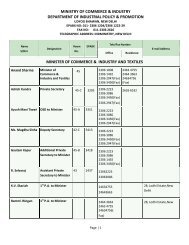fdi in india and its growth linkages - Department Of Industrial Policy ...
fdi in india and its growth linkages - Department Of Industrial Policy ...
fdi in india and its growth linkages - Department Of Industrial Policy ...
You also want an ePaper? Increase the reach of your titles
YUMPU automatically turns print PDFs into web optimized ePapers that Google loves.
SPECIAL ECONOMIC ZONES (SEZS) AND FDI IN INDIA<br />
generous tax holidays for manufactur<strong>in</strong>g un<strong>its</strong>, <strong>and</strong> unlimited duty-free imports of raw, <strong>in</strong>termediate <strong>and</strong> f<strong>in</strong>al goods as<br />
well as capital goods.<br />
4.10.2 Provision of Infrastructure <strong>in</strong> SEZs<br />
The provision of <strong>in</strong>frastructure was done on a regional basis rather than restrict<strong>in</strong>g the benef<strong>its</strong> to the SEZ alone. Cities<br />
like Shanghai started a comprehensive programme of resource mobilisation <strong>and</strong> expenditure management, <strong>and</strong> built new<br />
<strong>in</strong>frastructure. It set up separate transport <strong>and</strong> energy funds <strong>in</strong> municipal revenue collection, guarantee<strong>in</strong>g much of the<br />
fund<strong>in</strong>g for the two sectors, <strong>and</strong> tapped <strong>in</strong>to the <strong>in</strong>ternational market to lure direct <strong>in</strong>vestment. Municipal service<br />
departments were given full responsibility for plann<strong>in</strong>g, <strong>in</strong>vestment, operations, <strong>and</strong> ma<strong>in</strong>tenance. They adopted an<br />
<strong>in</strong>dependent cost-account<strong>in</strong>g system to facilitate sector management <strong>and</strong> f<strong>in</strong>anc<strong>in</strong>g, <strong>and</strong> <strong>in</strong>creased user charges for<br />
<strong>in</strong>frastructure services like bus transport, gas supplies, water, waste-water discharge, <strong>and</strong> sanitation services. The city also<br />
raised funds by leas<strong>in</strong>g l<strong>and</strong>, <strong>in</strong> the process attract<strong>in</strong>g a large volume of FDI <strong>in</strong>to real estate development, <strong>in</strong>clud<strong>in</strong>g<br />
commercial <strong>and</strong> apartment complexes that catered to foreign companies.<br />
4.10.3 Local Autonomy<br />
The <strong>growth</strong> process was accompanied by considerable delegation of authority to the prov<strong>in</strong>cial governments. Each was<br />
allowed to <strong>in</strong>troduce <strong>its</strong> own legislation to govern <strong>in</strong>vestment, approval procedures relat<strong>in</strong>g to foreign <strong>in</strong>stitutional<br />
enterprises <strong>and</strong> local tax concessions. Local authorities could clear foreign <strong>in</strong>vestment proposals without referr<strong>in</strong>g to the<br />
Centre. They were also permitted to reta<strong>in</strong> a large share of <strong>in</strong>cremental taxes generated as a result of the <strong>in</strong>creased<br />
economic activity, which was used to <strong>in</strong>vest <strong>in</strong> <strong>in</strong>frastructure as well as equity contributions to jo<strong>in</strong>t ventures with foreign<br />
<strong>in</strong>vestors. The four SEZs <strong>and</strong> their home prov<strong>in</strong>ces, Guangdong <strong>and</strong> Fujian, were awarded f<strong>in</strong>ancial benef<strong>its</strong> <strong>in</strong> the form<br />
of more advantageous fiscal <strong>and</strong> foreign exchange revenue contracts. Beg<strong>in</strong>n<strong>in</strong>g <strong>in</strong> 1980, Guangdong <strong>and</strong> Fujian were<br />
awarded five-year fiscal contracts permitt<strong>in</strong>g them to reta<strong>in</strong> almost all of the taxes <strong>and</strong> <strong>in</strong>dustrial prof<strong>its</strong> generated by<br />
firms <strong>in</strong> their jurisdiction. In contrast, the three prov<strong>in</strong>cial-level cities of Beij<strong>in</strong>g, Tianj<strong>in</strong> <strong>and</strong> Shanghai were still required<br />
to turn over 63 to 88 per cent of their revenues. In terms of foreign exchange retention, the SEZs were allowed to reta<strong>in</strong><br />
all of the hard currency they earned from trade, <strong>in</strong> contrast to the average of 25 per cent allowed to other localities.<br />
4.10.4 Labour Policies<br />
Under the planned economy system <strong>in</strong> Ch<strong>in</strong>a, the urban <strong>and</strong> rural labour forces were separated from each other <strong>and</strong><br />
deployed strictly accord<strong>in</strong>g to government plans. Urban job seekers were provided with employment by the government<br />
<strong>and</strong> rural labourers could not be employed <strong>in</strong> urban areas without the permission of the government. Employees had no<br />
right to choose their jobs <strong>and</strong> the employer had no right to select what they needed either. After the reform, the<br />
relationship between the employer <strong>and</strong> employee underwent a major change. In 1983, certa<strong>in</strong> localities experimented<br />
with gradual replacement of permanent employment with contract labour. The government formalised this practice <strong>in</strong><br />
1986 <strong>and</strong> promulgated “Provisional Regulations on Employment <strong>in</strong> State-owned Enterprises”. All the state organs,<br />
government <strong>in</strong>stitutions <strong>and</strong> state-owned enterprises had to execute labour contracts for new employees, either on longterm<br />
contracts (one year or more) or short-term contracts. In the 1995 Labour Law, contracts were made m<strong>and</strong>atory <strong>in</strong><br />
all <strong>in</strong>dustrial enterprises, <strong>in</strong>clud<strong>in</strong>g Town <strong>and</strong> Village Enterprises (TVEs).<br />
4.10.5 Tax <strong>Policy</strong><br />
Ch<strong>in</strong>ese SEZs usually did not provide a long tax holiday. Instead, production enterprises attracted a reduced tax rate<br />
with a substantial <strong>in</strong>vestment tax credit that varied from 100 per cent for <strong>in</strong>vestment <strong>in</strong> export-oriented <strong>and</strong> high-tech<br />
enterprises to 40 per cent for <strong>in</strong>vestment <strong>in</strong> other FIEs. Among the preferential policies for FDI firms <strong>in</strong> the SEZs were,<br />
for example, a reduction of <strong>in</strong>come tax to 15 per cent (FDI firms engaged <strong>in</strong> production <strong>and</strong> scheduled to operate for a<br />
period of 10 years or more were exempted from <strong>in</strong>come tax <strong>in</strong> the first <strong>and</strong> second profit-mak<strong>in</strong>g years <strong>and</strong> allowed a 50<br />
41












